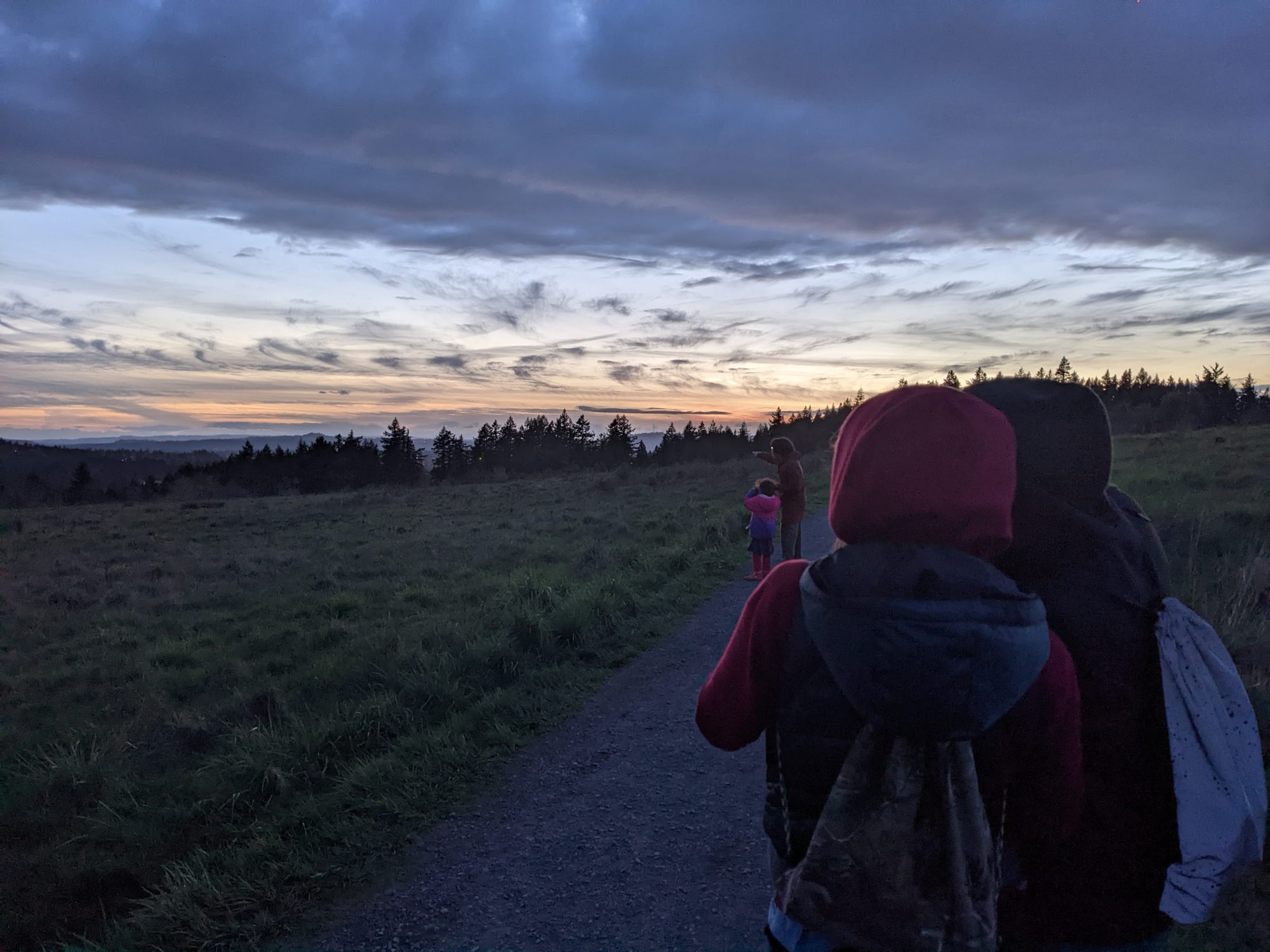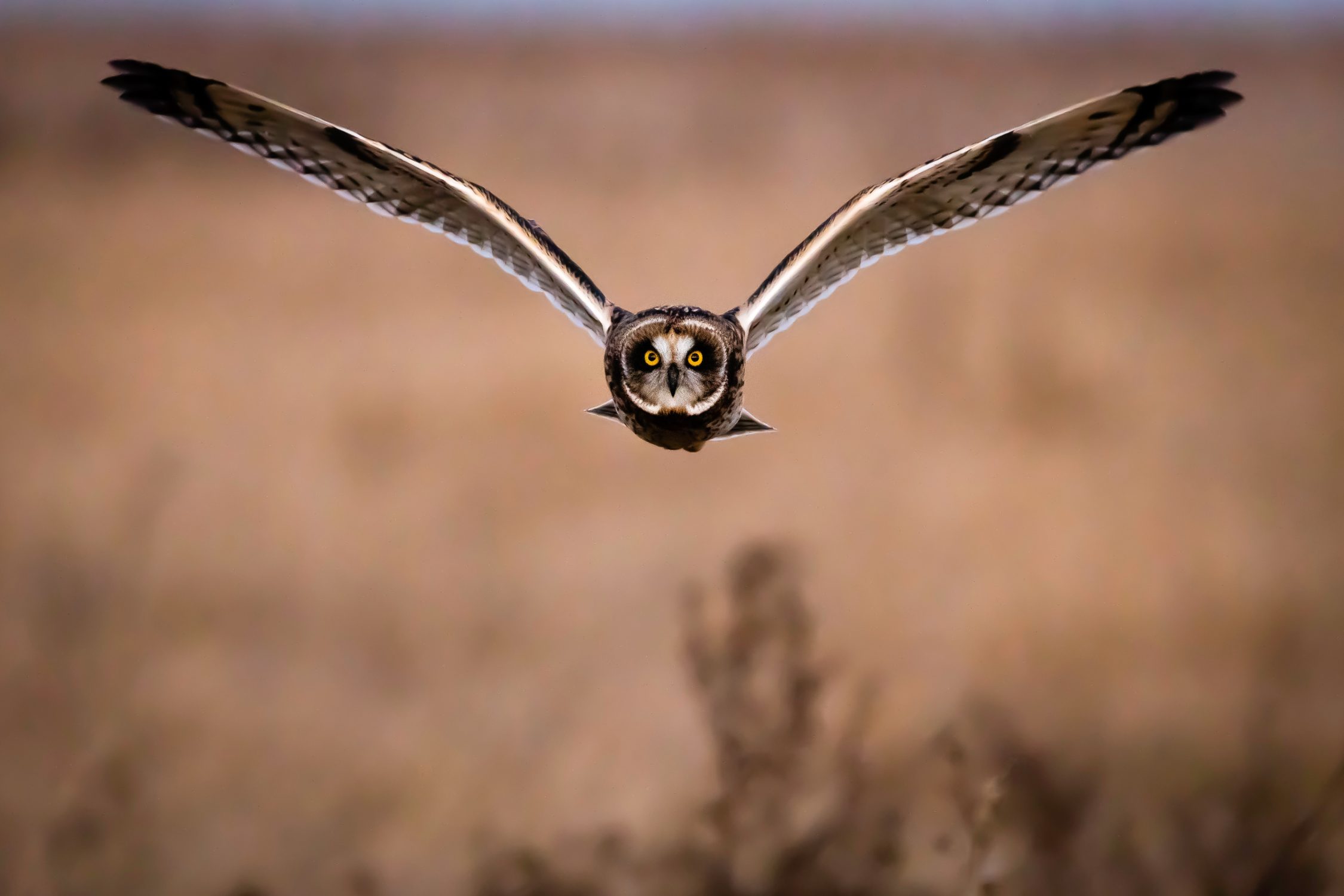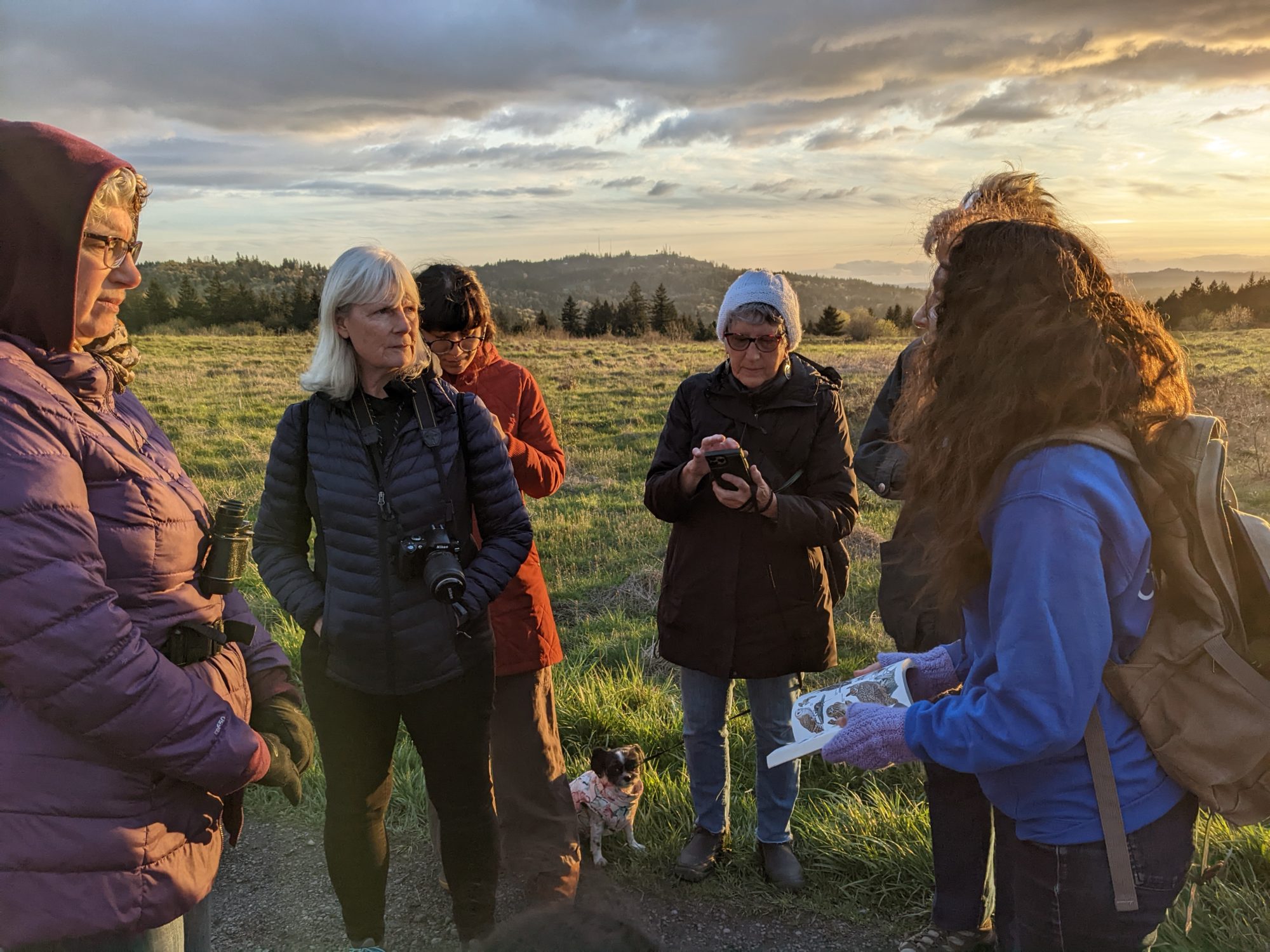We were overwhelmed (literally!) by the outpouring of interest in our Owl Prowls Last month. In retrospect, of course everyone would want to explore Powell Butte after dark and look for owls! If you were one of the many people who weren’t able to snag a spot on one of our two guided nature walks, don’t despair: we’ve put together this kit just for you. Keep reading to learn everything you need to DIY your own Owl Prowl.

Owls are beautiful and charismatic, but between their nocturnal habits and secretive nature they can be hard to find. To help people get a glimpse of these elusive birds, the Johnson Creek Watershed Council, in partnership with Portland Parks and Recreation, offered two “Owl Prowls” on Powell Butte in April of 2022. The events were so popular that we decided to put together this information to help anyone find owls on Powell Butte–and beyond.
Safety First
Hiking through the forest at night may sound alarming to some! It’s true that there’s a certain level of risk involved, but some common-sense precautions can help keep you out of trouble. Here’s some tips on staying safe while looking for owls:
Bring a buddy. Two people are always safer than one when encountering other humans, wildlife, or hazardous landscape features. Even something as simple as a twisted ankle becomes a much bigger problem when there’s no one to help you limp back to your car.
Be prepared. Wear the right clothes and bring the right gear for the activity. A flashlight or headlamp is a must if you will be out after dark. Don’t rely on your cell phone flashlight! Also crucial is a good pair of shoes, ideally with good ankle support. Flip-flops or flats are a sure-fire way to twist an ankle (see above!). Temperatures can drop unexpectedly at night, but hiking will get you sweaty. Wear warm, layered clothes and bring a raincoat so you’ll be prepared for whatever the weather throws your way. Bring a trail map and know where you’re going. Again, don’t depend on your phone!
Timing is Everything
To find owls, just… go outside at night, right? Not so fast! It’s true that most owls are nocturnal, but many are actually more active at dawn or dusk (the fancy scientific word is “crepuscular”). Plus, some owls are more active at certain times of year, or are only in Oregon for certain months. On top of that, Powell Butte isn’t open at night! So when should you try to find owls? We’ll lay it all out for you.
Know the rules. While it may seem strange that a forest has “hours,” Powell Butte is a city park and it opens and closes just like any park. Park hours change with the season, so check the Powell Butte website for the most up-to-date information. Be aware that some signs posted around the park may have outdated information; always follow the hours posted online. The main entrance has a gate that will lock at closing time; if you’re still in the park, your vehicle will be locked in the park. If you’re worried about losing track of time and getting stuck, park outside the park and hike in from one of the outer trailheads. All that extra walking is a blessing in disguise, because as you hike you can listen for owls. But remember that just because there are no gates on these trailheads doesn’t mean they’re open 24 hours a day! Even if you hike in, you’re still required to obey park rules and be out of the park by closing time.
Time of day. From a low of about 4:30 pm at the winter solstice, the sun begins setting later and later until the summer solstice, when it sets around 9:00 pm. Why is this important? Sunset is your best time to see and hear owls. Many owls are crepuscular, and even those that are fully nocturnal may be most vocal just after the sun sets. It’s certainly possible to find owls during the day, but it’s often down to luck. When the sun is up, most owls hide in thick branches close to the trunk of a tree, where their camouflaging feathers render them nearly invisible. To find owls in daylight, pay attention to other birds, especially crows and jays. When these birds find an owl, they’ll gather a large flock and call loudly in an attempt to drive the owl away. A noisy flock of jays might lead you straight to a roosting owl!
Time of year. Many species of birds come and go throughout the year as they migrate from the place they nest to the place they spend the winter and then back again. Other species are present year-round, but may be harder to find during the breeding season, when they’re busy raising a nestful of chicks. Owls are no different. Short-eared owls breed in the north, and only come to the Portland area in the winter. Barred owls are here all the time, but are easiest to find in spring and early summer. While you can find owls on Powell Butte in any month, spring may be the most productive time to go searching for them. Winter migrants like short-eared owls haven’t left yet, and resident owls like barred owls are hooting loudly to establish their territories for the summer breeding season.
Know Your Owls
Take a little time before you leave to familiarize yourself with the owls you’re most likely to find. Each species of owl looks, sounds, and acts in a unique way that will help you find, identify, and understand it. Study some pictures so you know what to look for, and listen to each owl’s hoot so you know what to listen for.

Short-eared owl. This large, migratory owl can be found cruising low over ground in open, grassy areas. Every year one or two short-eared owls choose to spend the winter on Powell Butte before traveling north to breed. Look for this owl on the grassy top of Powell Butte right at sunset, or just before sunset, from January through March. It’s a very distinctive bird that’s hard to confuse with anything else: look for the stocky body, long pale wings, and powerful wingbeats.
Great horned owl. This is the classic owl you’ve seen in every cartoon or drawing of an owl. They’re found on Powell Butte year-round, but are easiest to find in winter and spring. You’re unlikely to see one, though, because they’re active at night and hide during the day. Instead, listen carefully for their hoots as you walk through the forest at dusk.
Barred owl. Infamous for their aggressive behavior toward their endangered cousin, the Northern spotted owl, barred owls have eerie all-black eyes and a distinctive streaked (or “barred”) breast. However, like the great horned owl, you’re not likely to actually see them. Listen for their unmistakable “who cooks for you?” call as you walk through the forest. This is another year-round resident owl, but they’re most likely to be found March-June.
Less common owls are the Northern pygmy-owl and the Western screech-owl. Both of these species are secretive forest owls best found by listening carefully in the forest during the spring. You may have better luck hearing the Northern pygmy-owl at dawn, rather than dusk. Finally, barn owls are uncommon visitors to the grassy top of Powell Butte that you might confuse with the more reliable short-eared owl.
How to Prowl
Ok, so you and your buddy have your hiking shoes and headlamps on, you’ve checked when the sun sets and when the park closes, and you know everything there is to know about the owls of Powell Butte. Now what??

Bring a good attitude. You never know what you might find when you look for owls, and the sad truth is that what you find might be… no owls. Be prepared to enjoy whatever you see and hear, whether there are any owls or not. If you are patient, flexible, and curious, you can have a great time no matter what happens.
Take a hike. Just start walking! As you walk the trails at Powell Butte, think about what kind of habitat you’re walking through, what time it is, and what kind of owls you’re likely to find. Are you walking through the forest? Use your ears and listen for barred owls and great horned owls. Are you walking through the meadow at dusk? Keep your eyes peeled for a short-eared owl. It’s as easy as that.
Use the tools you have. You may think you need a lot of fancy, expensive gear to find owls, but you can go owl prowling with nothing more than your eyes and ears. It is true, however, that the right tools can make your search easier and more fun. Even a small pair of binoculars can help you see a swooping short-eared owl. An app on your phone can play owl hoots to help you identify what you’re hearing. (Please remember, if you’re playing owl calls on your phone, to play them on headphones or quietly. If a real owl hears you, it can mistake your phone for another owl and become very stressed.) A bird guide can tell you what to look for when identifying owls. The Audubon Society has an excellent guide for choosing binoculars, and many of these binoculars can be purchased from the Portland Audubon Nature store or the Backyard Bird Shop. For your phone, Merlin and Audubon are two free apps that include sound. Powell’s, the Backyard Birdshop, and many independent bookstores carry a wide selection of bird guides.
An example owl prowl. To put this all together, let’s say you want to look for owls in mid-March. On March 15th, Powell Butte closes at 8pm, and sunset is about 7:15pm. You and your buddy, prepared with warm layers, good shoes, a trail map, and a head lamp, could leave from the Ellis Street trailhead on the west side of Powell Butte at 6pm. Take your time walking through the forest to the grassy summit of the Butte, listening for great horned owls and barred owls as you go. At the top of Powell Butte, stroll slowly around the meadows until a little after sunset, to see if the short-eared owl will appear. If it does, admire it as it flaps gracefully over the grass until the light begins to fade. Then hike back the way you came, listening carefully in the forest again. If you hear something and you’re not sure what it is, break out your smartphone and (quietly) play some hoots. Do any of them match what you hear? You can make it back to the trailhead before 8pm and congratulate yourself on a successful Owl Prowl!
Beyond Powell Butte
Powell Butte is not the only place in the Portland area to see and hear owls. The area around the Portland Airport, like Broughton Beach, is another great place to see short-eared owls. Forest Park, along with many smaller parks such as Mount Tabor and Errol Heights, are all great places to find forest owls like barred owls and great horned owls. Always be sure to check park regulations and hours before you go. (Note that park hours are not listed for Errol Heights Park, but Portland Parks & Recreation recommends you leave the park by 10:00 PM.)
All you need to find owls is a little knowledge and a sense of adventure!
